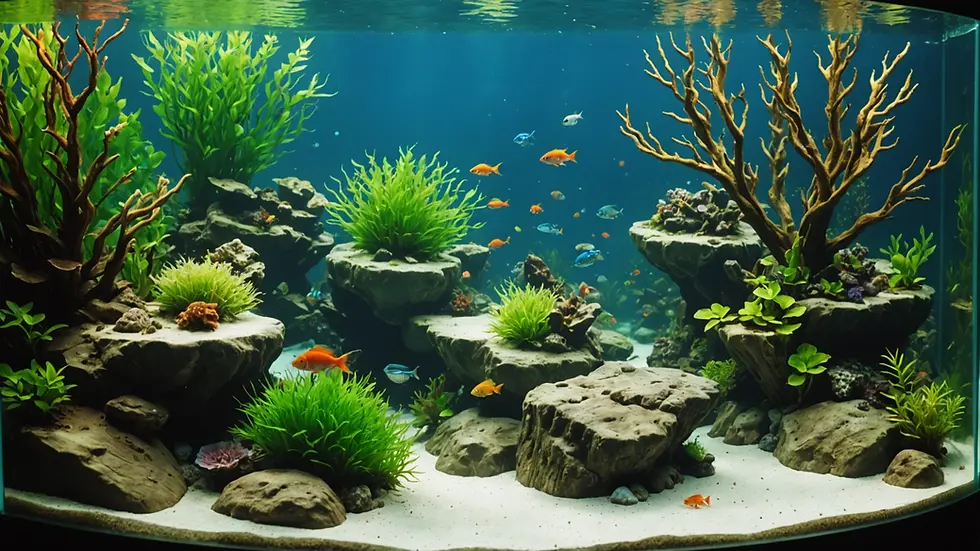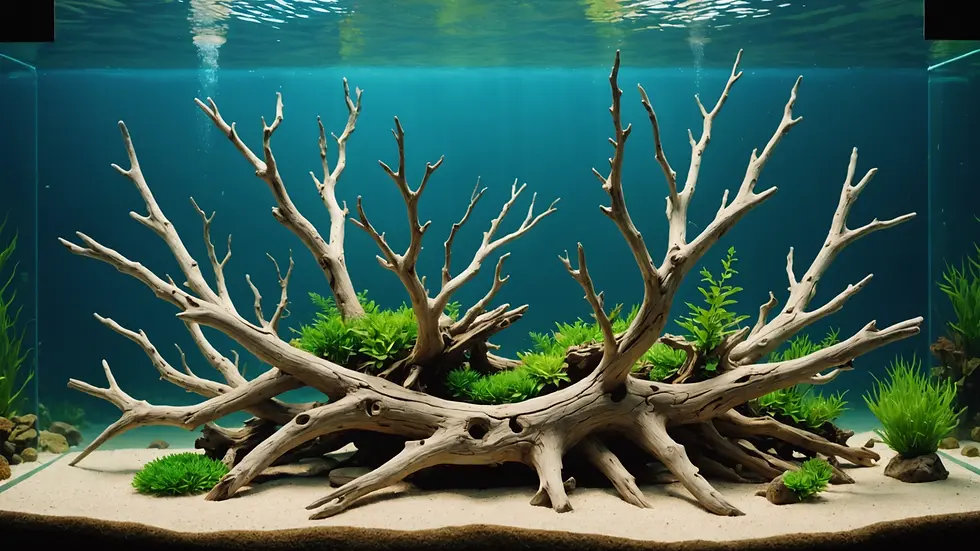Unleashing the Underwater Wilderness: Crafting a Serene Habitat for Your Aquatic Companions
- Jyotiraj Borah
- Feb 5
- 4 min read
Creating a natural habitat for your fish goes beyond mere looks; it’s about building an environment that mirrors their native waters, ensuring their health and happiness. Imagine stepping into a world where vibrant fish swim freely and lush plants sway gently with the flow of the water. This guide presents practical tips to help you design this underwater paradise for your aquatic companions.
Understanding Your Fish's Needs
Understanding the specific requirements of the fish species you plan to keep is crucial before starting your habitat design. Each species has distinct preferences, from water temperature and pH to compatible tank mates. For example, tropical fish, like Neon Tetras, thrive in warmer waters around 75-80°F with a pH level between 6.0 and 7.0. In contrast, goldfish prefer cooler temperatures of 65-75°F and a more alkaline pH of around 7.0 to 8.0.
Researching these needs allows you to choose the right plants, decorations, and even substrate, creating a tailored environment for your fish.
Selecting the Right Aquarium Size
The aquarium size is central to developing a suitable habitat. Larger tanks provide better stability in water conditions and ample swimming space, enhancing the well-being of your fish. A minimum size of 20 gallons is generally recommended for most species. For instance, keeping a school of six Platies in a 20-gallon tank allows each fish enough space to swim, reducing stress.
In addition, larger aquariums can support a more diverse ecosystem with plants, rocks, and driftwood, enhancing the natural appearance of the habitat.
Creating the Substrate Layer
The substrate layer is vital in your fish's habitat. Fish feel more comfortable in tanks with a substrate that resembles their natural surroundings.
For freshwater aquariums, a few substrate options include:
Sand: Ideal for bottom-dwelling fish like Corydoras catfish, providing a soft and gentle surface.
Gravel: Suitable for most species and supports plant growth, particularly good for Java Moss or Anubias.
Before adding the substrate to your tank, rinse it thoroughly to remove dust and debris. A substrate depth of 1 to 2 inches is usually sufficient to help plant roots anchor and provide a natural look.
Adding Aquatic Plants
Plants greatly enhance your aquarium's beauty and provide essential hiding spots and breeding areas. Opting for live plants creates a healthier ecosystem by filtering water and releasing oxygen.
Some beginner-friendly aquatic plants are:
Java Fern: Tolerates various light conditions and thrives without much fuss.
Water Wisteria: Grows quickly and helps improve water quality.
When planting, position taller plants in the back and smaller ones in the front. This layout mimics natural underwater landscapes, enhancing visual appeal while ensuring all plants receive enough light.
Incorporating Rocks and Driftwood
Rocks and driftwood offer interest and structure to your aquarium, creating natural hiding spots for your fish. Choose safe materials to prevent harmful chemicals from entering the water.
You can use slate or granite, stacking them to form caves. Driftwood not only provides texture but also surfaces for beneficial bacteria to grow, improving your aquarium's filtration.
Strategically placing these elements can minimize aggression among fish by providing physical boundaries. This is particularly important when housing territorial species.
Maintaining Water Quality
Maintaining water quality is essential for a thriving aquatic habitat. Regular testing for pH, ammonia, nitrite, and nitrate levels is crucial.
Invest in a quality water testing kit and perform weekly water changes of 10-15% to keep your tank clean and fish healthy. Installing a reliable filtration system helps remove toxins and promotes proper water circulation.
Providing Hiding Spots and Open Spaces
Creating environments where fish can exhibit natural behaviors is vital. Combining hiding spots with open swimming areas supports their well-being.
Hiding spots, provided by plants, rocks, and decorations, make timid species feel secure, while open spaces allow for active swimming. Regularly observe your fish and adjust the layout based on their behavior and preferences.
Ensuring Proper Lighting
Light is crucial in creating a balanced habitat. Tailor the type and intensity of lighting to suit your fish and plants.
LED lights are energy-efficient and versatile, allowing you to simulate a natural day-night cycle. Aim for about 8-12 hours of light daily to nurture healthy plant growth while preventing excessive algae.
Be mindful of lighting placement, as some species prefer dimmer conditions. Adjust as necessary to meet the needs of both your plants and fish.
Selecting Compatible Tank Mates
Compatibility is key in maintaining harmony within your aquarium. It's important to research the temperaments, sizes, and needs of potential tank mates.
Housing fish with similar size and behavioral traits is generally advisable. For example, consider keeping peaceful species like Corydoras and Neon Tetras together, while keeping aggressive species like Cichlids separate from more peaceful tank mates.
When introducing new fish, acclimate them slowly to the tank to ease the transition and reduce stress.
Regular Maintenance Practices
A successful aquatic habitat requires consistent upkeep, including regular water changes and monitoring the health of your fish.
Check your water filter and clean it as needed. Regularly remove any dead plants or uneaten food from the substrate to maintain cleanliness. Following a consistent feeding schedule supports healthy fish growth, ensuring their nutritional needs are met.
Observing Fish Behavior
Observing your fish provides valuable insights into their well-being. Look for signs of stress, such as excessive hiding, rapid gill movement, or refusal to eat.
Changes in behavior often stem from water quality issues or conflicts with tank mates, signaling the need for further inspection.
Creating an environment that makes fish feel safe leads to happier, healthier aquatic companions.
A Joyful Journey
Designing a natural habitat for your fish is a fulfilling journey that enhances both your aquarium's beauty and the health of its inhabitants. By understanding the unique needs of your fish and choosing suitable substrate, plants, and decorations, you can create a serene underwater sanctuary that resembles their natural habitat.
Ultimately, the effort you invest in crafting this environment will lead to happier fish. Enjoy the process of becoming an aquarium steward and witness your aquatic companions thrive in their carefully curated underwater wilderness.







Comments